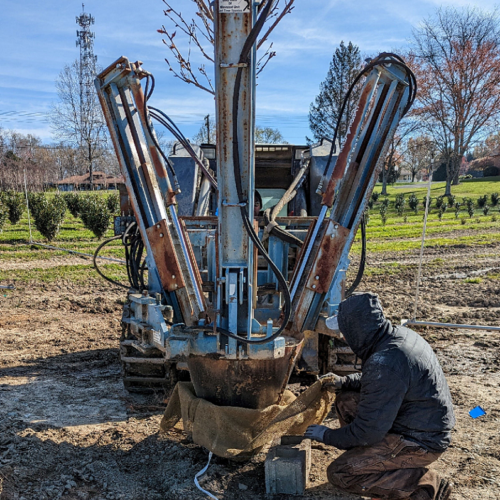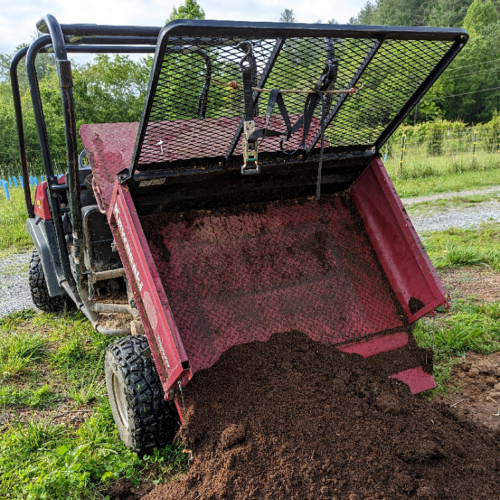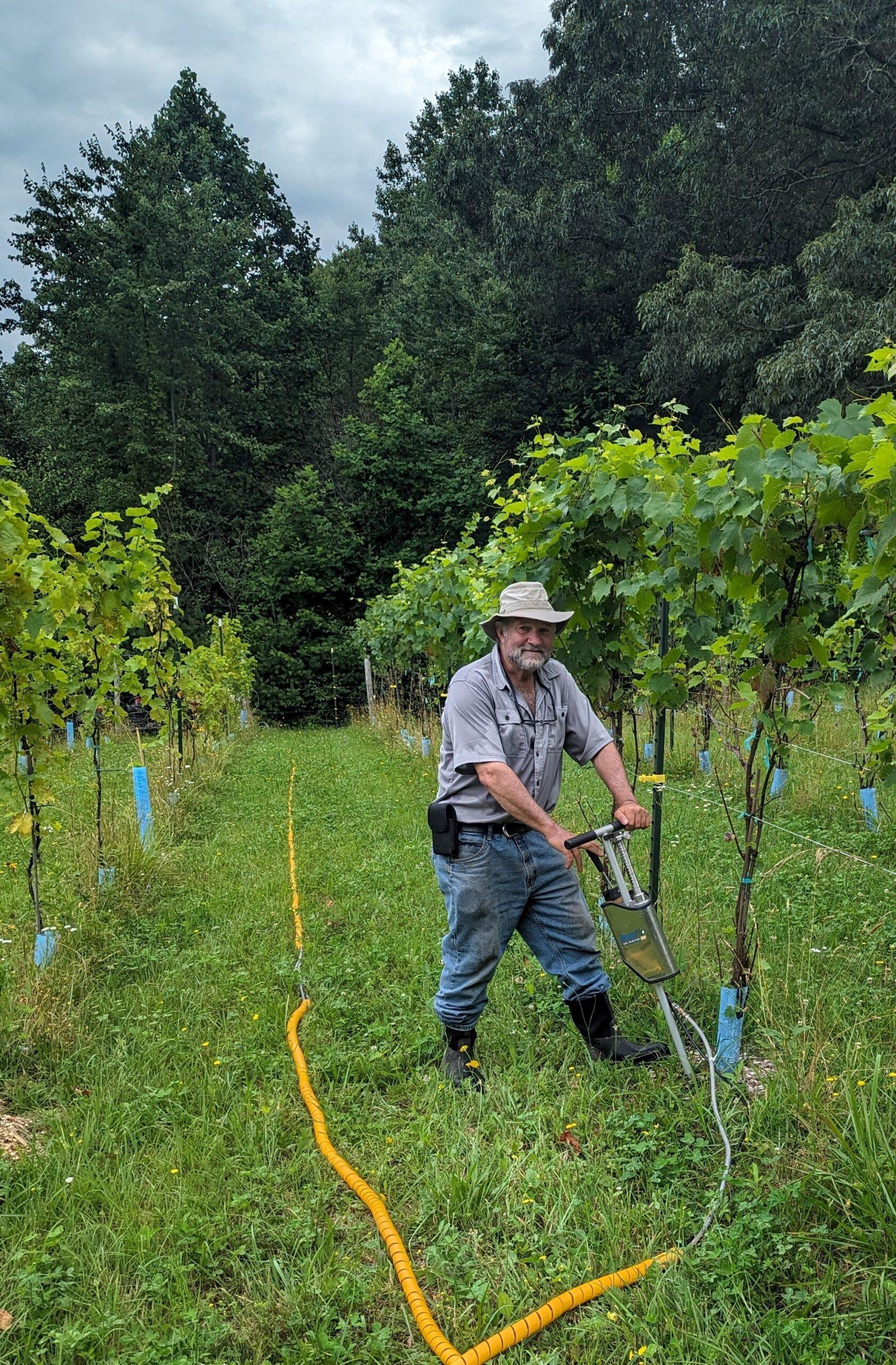Favoring Plant Health in Unfavorable Climate
First some plant basics:
How Plants Grow
From seed, a plant first sends out roots. A radical idea, no? The plant requires anchoring, water and a few solutes before it sends up its above ground parts. Roots also require gas exchange. The process looks like this:
O2 → CH2O = CO2 + H2O.
Look familiar?
Therefore, the root environment needs to be porous enough for carbon dioxide to dissipate and for oxygen to infiltrate. That’s correct: roots respire! This is especially true for the top 6 to 12” of soil.
Once the root forms, the seed sprouts a single stem and leaf (monocot) or two leaves (dicot). Leaves are photosynthetic and make food for the plant in the form of sugars. The process looks like this:
CO2 + H2O → CH2O + O2.
It is the above ground parts that need sunlight to make sugars and more complex carbohydrates for growth and development. The roots provide the above ground parts with water and dissolved minerals so that photosynthesis can go forward.
Essential Exchange within the Plant
A short list of what roots and the above ground parts need and provide:
- Roots need air, water, dissolved minerals, drainage and a substrate into which to anchor
- Roots need sugars from the above ground parts
- The above ground parts need sunlight and depend on roots for water and essential elements (minerals)
How Much Water Does a Tree Need?
Here are a few basic assumptions to use to calculate a trees’ water needs:
- The root zone critical to water absorption (CWA) is defined here as one foot for one inch of tree diameter at breast height
- One inch of rain is required per week during the growing season
For example, if a tree is 24” in diameter, its CWA is 24 feet. One inch of rainfall delivers 180 gallons to the tree’s roots (24 feet root zone x 1” rain /12 = 24 cu ft; 1 cu ft = 7.5 gal. x 24 cu ft. = 180 gal). Using these simple assumptions, you can calculate your garden or landscapes watering needs.
New Plantings
Plants need more water when they are first transplanted. In the process of digging and moving plants, some, if not most of the water-absorbing roots are left behind. This is especially true of dug trees, but less so for plants grown in pots.
A smaller root system supporting the same above ground parts causes a plant to wilt. To alleviate wilt symptoms, water thoroughly at planting.

How Frequently to Water
Watering frequency depends on rain events, but also depends on your soil type. There are three basic soil textures. These are:
- Sand (coarse textured)
- Silt (medium textured)
- Clay (fine textured)
Sandy soils are termed coarse soils. They have relatively large soil particles that are loosely arranged and drain fast. These soils do not hold moisture long, so more frequent watering is required.
On the opposite extreme are clay soils. These are made up of very fine particulates that stick tightly together. These soils do not drain well, and when wet tend to stay wet, but when dry become brick-like. These soils are a bit harder to manage.
Soils tend to be a mix of particulates. When we speak of loam, we mean a soil that is a mix of 40% sand, 40% silt and 20% clay: the “ideal” soil type. Refer online to the Soil Texture Triangle to categorize your soil type.
Watering frequency also depends on plant type.

Water Conservation Practices and Sustainability
It ought to be clear at this point that plants need water. They need to be watered regularly during the growing season. Without water, they could not photosynthesize or even remain turgid. One of the indications of water stress is foliar wilting. Here are some practices to help reduce the evaporative losses from the soil:
- Compost
- Mulch
- Add humates
- Add seaweed
- Add sugars
- Use a moisture manager
Compost
Layer compost before adding mulch. For woody plants, use a compost from fallen leaves and twigs. This composition favors an environment favorable to fungi. For turf, use a compost from grass clippings mixed with dry straw. For forbs (broadleaved garden plants) use a compost made from kitchen scraps bulked with dried leaves. These latter favor a high bacterial component, which favor herbaceous (non-woody) plant growth.

Mulch
Use an organic mulch to cover the earth. A layer of 4 to 6” is adequate in most cases. Not only will mulch reduce water loss, creates a cooler root run, it will help support beneficial soil and root microbes.
The additions of composts and mulches are generally made once or twice in a year. For supplemental additions, consider humic acids, seaweed and sugars in liquid form. Additions during the growing season, from summer to early winter will help to reduce summer (high temperature) and winter (low temperature) stresses.

Humic Acid
Humic acid is a solubilized form of Leonardite ore, a carbon source. Humates have a very high cation exchange capacity (CEC). That is, humic acids hold positively charged ions such as potassium, calcium, magnesium, iron, manganese, zinc and other minerals. This effect allows nutrient chelation that increases their plant availability. The high carbon stimulates microbial activity in the soil, improving mineral availability. One liquid source high in humic acid is EnviroPlex.
Seaweed
Superior seaweed extracts are derived from Ascophyllum nodosum. Sourced from the Bay of Fundy, and found in the intertidal zone, this seaweed is constantly exposed to extreme stress. To survive the environmental extremes of the intertidal zone, the seaweed produces protective substances including, polyphenols, carotenoids and is a source of minerals and organic acids. In addition, A. nodosum is considered to be a plant biostimulant, supplying auxins, gibberellins and cytokinins (all plant growth regulators). When applied to plants, seaweed has been shown to optimize the plants’ potential for root development and stress tolerance. These benefits are advantageous for new plantings and to protect existing plants from temperature extremes, drought, salinity, and other environmental stresses.
Carbon and Nitrogen Fertilizers
Fertilizers that supply a nitrogen and carbohydrate value are designed to stimulate beneficial soil microbes. Look for fertilizers that supply molasses as the primary source of carbohydrates. The microbial component in the soil helps to support plants in a number of critical ways. These include:
- Supporting nitrogen-fixing bacteria
- Fixing atmospheric nitrogen for plant use
- Supporting naturally occurring mycorrhizae
- Solubilizing minerals such as phosphorous from the soil

Use of Moisture Manager
In regions or times of year experiencing drought conditions, application of water is essential. To optimize water use, consider a moisture manager. Some, such as Hydretain ES are based on a humectant (rather than a gel) technology. Humectants draw water to them. Moisture managers are designed to draw ambient moisture to the roots for absorption. The use of a moisture manager could reduce watering requirements by as much as half.
Rethinking Plant Health Care
How are we to meet the challenge of a changing climate? Here are a few concepts worth considering:
- Get familiar with your environment
- Plant a diversity of species
- Plant woody plants in the dormant periods: spring and fall
- Plant herbaceous plants spring, summer and fall
- Plant like a Native American
The Environment
Before planting a tree, consider your environment. What exposures do you have on your property? Northern? Southern? Eastern? Western? Exposed? Sheltered? Sunny? Shady? Take advantage of natural air conditioning of your home by planting (deciduous) shade trees in the south and west, the hottest aspects in summer. Plant an evergreen windbreak on the north side, to keep your home warmer in winter. You get the idea.
Take soil into consideration. If it is clayey or compacted, then you need to consider some fixes. This may include:
- Physically breaking up the soil
- Constructing raised beds
- Additions of organic matter
- Adjusting pH
- Access to water
- Allowing for drainage
Some soils may be so highly compacted, that physically breaking up the soil may be required. This technique allows for roots to get into the ground. However, physical tilling is not enough. Additions of a good quality organic matter will help to keep the soil friable (breathable). Apply 10% by volume. After working the soil, this is a good time to test for pH. Is the soil in the range for the plants you plan to grow? In acidic soils (pH<6.0), add pelletized lime. In alkaline soils (pH>8.0), add an acidifier such as NutralyzTM (liquid ammonium thiosulfate).
If your soil is completely unworkable, then the only way to go is up. Construct a raised bed. Depending on your circumstances, this may simply involve adding good quality loam to raise the grade into which you can plant, or using materials (stone, brick, PT lumber) to construct a formalized raised bed.
When grading soil, grade away from built structures such as house and driveway. If the grade does not allow for this, a French drain may need to be considered.
If you install an irrigation system for watering trees and shrubs, avoid the automatic settings for turf grasses. Frequent, shallow irrigation results in shallow roots that are more prone to drought stress. Rather, the frequency of watering is one thorough watering per week of an inch a week. In new plantings, twice a week at ½” per watering until root establishment.
Consider a Mixed Planting
Plant your overstory first. The overstory provides shelter for understory plants. The overstory are your shade trees. The understory are woody shrubs, perennials and annuals. If you mix in a few aromatic plants (one a composite, such as marigolds, the other an herb, such as mint), you will at the same time attract beneficial insects to the planting.
Grouping plants will help to increase their resiliency against the vagaries of climate and weather.
Plan on planting in early spring and late fall. These are times that are less stressful to plant and planter.
Plant like a Native American
When Native Americans planted corn, they planted four to a hill. That is, one was for the bird to take, the second was for the worm to eat, the third was for drought, the fourth was to grow. In a sense, plan for success, and this means plan for failures as well.
One more bit of advice: when planting a vegetable garden, sow some seed every two weeks. Early on in the season, this will give you a second chance if frost hits the earlier crop. With brassicas, a spring crop may get hit by caterpillars, but not a fall crop. Staggering plantings also has the benefit of not growing more than you need at any one time.
If one were to consider how much seed is produced by a tree (thousands), and the number that survive to grow to maturity, the percentage is very low, in the neighborhood of 1%. With some of the techniques described here, we can up your gardening success by 25 times! Think of success, but plant like a Native American!
Next week, we’ll talk more about some shade trees of summer.
– Signing off for now, Joe

